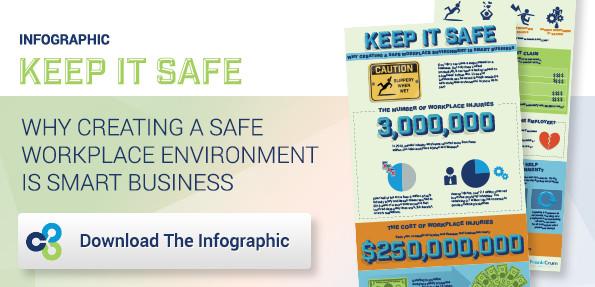 Did you know that more than 3 million workplace injuries occur every year in the U.S.? These injuries can be devastating to the worker and his/her family, and to the business as well.
Did you know that more than 3 million workplace injuries occur every year in the U.S.? These injuries can be devastating to the worker and his/her family, and to the business as well.
But by fostering a safe work environment, business owners can make great strides toward accident prevention.
Being an effective and responsible employer means it is your duty to create a safe work environment for your employees.
Even if you’ve never had a workplace accident occur, without a proactive accident prevention plan you’re taking a gamble.
Depending on the type of work your employees perform, your odds may be poor, and even the seemingly safe jobs carry some degree of risk. So rather than weighing the odds, the better approach is to be proactive to create a safe work environment.
Steps to a Safer Workplace
There are a lot of moving parts (quite literally) when tackling workplace safety, and your exact approach can differ depending on your industry. However, it is important to note that no industry or company is exempt from following safety practices, no matter if it is an office or construction site.
Here are some steps you can take toward improved work safety:
- Make safety a measurable performance factor for your supervisors. After all, they are the ones who should be establishing and monitoring procedures to ensure safe practices are in place and maintained.
- Communicate and be proactive. Sometimes an employee may have had different rules and standards at their previous job. Putting up posters isn’t enough—if something isn’t being done right, relay this at employee meetings and have refresher sessions for long-time employees.
- Have an open door policy. Make sure employees feel comfortable coming to you regarding safety issues, conditions and hazards.
- Reward good behavior. While disciplinary actions are necessary in certain situations, it’s important to also reinforce when things are done right, so good behaviors will be repeated.
- Monkey see, monkey do. Just like your supervisors, you need to spearhead safety as a top priority. Become an evangelist for safety, and your workers will file suit.
- Have a plan in case injuries happen. Not having Workers’ Compensation Insurance or a procedure for reporting and filing a claim when an accident occurs can mean trouble for you and your business.
Don’t be afraid to ask questions or change and adjust a company safety policy if it means your employees will be safer. Doing so shows that you are invested in safety, and making safety your priority will benefit everyone involved.
Why Safety Matters
Would any employee want to work somewhere that they don’t feel safe? And how successful will a business be if accidents take workers off the job? Keeping things safe and running smoothly is the name of the game.
Workers will feel safe and satisfied, and business can continue without interruption and added factors to manage that are time-consuming and costly. Investing in safety is simply smart business.
And on the flip-side, accidents in the workplace are very costly. Remember that statistic of more than 3 million workplace injuries that occur each year in the U.S.? Well, those accidents cost U.S. businesses nearly $250 million dollars.
For each dollar invested in safety prevention, a business can yield up to a $6.15 return on investment. The business case is compelling for effective accident prevention.
The Takeaway
Consider implementing the above-mentioned steps into your safety strategy. Creating a safer work environment for your employees can make a world of difference.
We have a great infographic that outlines insightful statistics and figures to help you even more with fostering a safe workplace; click below to access it.





